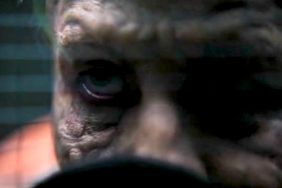David Goyer wants to invite you to a beautiful locale where everyone commits suicide. It’s called Aokigahara, a.k.a. “Suicide Forest,” and the it’s the creepy setting for his new psychological horror thriller The Forest, about a woman named Sara (Natalie Dormer) who runs off to Japan to save her identical twin sister before she can commit an unthinkable act.
The Forest is only the latest in a long line of genre films from Goyer, who has spent the majority of his career writing and/or producing comic book movies (The Dark Knight Trilogy, Man of Steel), horror movies (Demonic Toys, Unborn) or both (Blade, Ghost Rider: Spirit of Vengeance). Goyer produced and came up with the story for The Forest, which premieres just a few short months before his next big blockbuster, Batman v Superman: Dawn of Justice, arrives on March 25, 2016.
In the first half of our in-depth interview, we spoke to David Goyer about the origins of The Forest, the difficulties inherent to making a horror movie that costs more that $5 million in the contemporary studio environment, and his strange new task of rebooting the Batman film franchise for the second time.
Come back tomorrow, when our interview concludes with a retrospective of some of David Goyer’s stranger films, including the troubled sequel The Crow: City of Angels and the Nick Fury: Agent of S.H.I.E.L.D. TV movie that starred David Hasselhoff.

Gramercy
Related: The 50 Best Horror Movies of the Century (So Far)
Crave: The Forest is based on a place that is called a “suicide forest.” Was Suicide Forest too depressing a title to consider?
David Goyer: You know, we went back and forth. I think that was the title of the first draft. It wasn’t so much that it was too depressing, because we had to debate about whether or not in the trailer and things like that we should talk about that. But then you know, the Aokigahara, that’s the colloquial name, “The Suicide Forest,” so we don’t hide from it. The other name for it is the jukai, the “Sea of Trees.”
At the end of the day we just felt The Forest was a scarier title but we didn’t hide from the subject matter. It’s all over the marketing materials.
I think there are some people who think of horror movies as a sort of fun escapism, and here’s one that’s very confrontational about suicide…
Oh yeah.
Which is sad. Depressing.
Yeah, but you know, look, my particular brand of horror is not fun and frothy, in terms of what I like. I like It Follows. I like The Babadook. I like Don’t Look Now. I like Suspiria. I like Repulsion. I like The Shining. I like films that make you feel uncomfortable and where often there isn’t a happy ending. So that was the kind of film we wanted to make. We wanted to make a film that harkened back to the supernatural thrillers that were being made in the ‘70s, that major studios don’t tend to make these days.
“The Shining, Rosemary’s Baby, Don’t Look Now, none of those have happy endings or are all sort of wrapped up in any little bow.”
Why do you think that is? Is it just a budgetary concern?
Well, partly it’s a budgetary concern. All these studios are making what they call “micro-budget” horror films now, the under-$5 million model, which we did not want to do. This was more about $9 million. And some of those films, not all of them, but some of those films I think are being churned out a bit more like a sausage factory. Which is not to say some of those aren’t great but we wanted this to feel classy and we wanted it to feel elevated, from the score to the production design to the cinematography.
I think that mainstream studios tend to like happy endings and we were very set on – and fortunately Focus/Gramercy backed us on this – we wanted an ambiguous ending and we were okay with it being a downer. Because if you look at most of the films that I cited, that are considered these classic films, whether [it’s] The Shining, Rosemary’s Baby, Don’t Look Now, none of those have happy endings or are all sort of wrapped up in any little bow. I like horror films that you take with you, that are disturbing.

Gramercy
One of the other things that I think is very interesting about this film is the location. Japan is a place from which horror filmmakers have lately been, in the last 15 years or so, really taking a lot of inspiration. It’s a culture that has a different tradition of horror. Was that part of the appeal, to explore that different side of the supernatural?
Absolutely. At least for western audiences, Japanese folklore is not something that they’re completely familiar with, and this is all unconscious but I think because it’s not a traditional – it’s not an exorcist story that sort of falls on Judeo-Christian mythology and things like that – it’s not like there’s a neatly defined set of rules for how yurei work or what they want or how to defeat them. It feels alien and different, and I think that’s more unsettling.
But that was all deliberate and that was why we wanted to shoot some of the film in Japan. We wanted it to have that Lost in Translation feel. We talked about that a lot. And we wanted the forest, to a certain extent, to be unknowable, and to be something that you couldn’t really negotiate with. We thought that that was more disturbing.
“[There] are days when I kind of wish I could be involved in some other kinds of films as well.”
Is that why it was important to have this story be about two foreigners visiting Japan?
Exactly. Exactly.
That’s got to be a marketing decision as well though, right? Isn’t it easier to sell that in America?
Well, yeah, but more importantly it came from story. Like I’ve traveled a lot. I’ve been to a lot of far off places. I’ve been to Tibet, I’ve been to Burma, I’ve to Lao, I’ve been to a lot of places, and I’ve been to a lot of places where I’ve [been] the only caucasian person. And it’s definitely different when you can’t speak the language and when you’re in a different culture that you don’t understand and you feel different.
And so we wanted to Natalie [Dormer]’s character, Sara, to have that experience from the moment she gets off the plane in Tokyo. That’s why we just start then. You know, here you are, getting off a plane. You’re in Tokyo. You don’t speak the language. Everything’s different. Everything is destabilized and then it just gets more and more screwed up. I think that when a character or protagonist feels disenfranchised, I think that’s also scary because she increasingly becomes more and more alone. We strip everything away from her as the film progresses.

Gramercy
You said that the idea for The Forest was yours, but you didn’t write the screenplay. How much did you give the writers? Was it just, “Suicide Forest, run with it” or did you have an idea for the story?
No, no, no, it was not that. [Laughs.] I had the whole basic idea worked out. I [had] the idea of a young woman who goes to Japan in search of her sort of suicidal twin, and I had the idea of her hooking up with a westerner and then a Japanese guide. The basic concept is what I came in with and then we worked with writers to shape the screenplay.
Is The Forest a unique location, or are there other places like it we can go in sequels?
Interesting question! I will tell you, if we’re fortunate enough to do a sequel I have an idea that explores that.
How many David Goyers are there? Because if you look at your career from the outside, you jump back and forth a lot between the action-slash-superhero and horror genres. Is there a romantic comic version of David Goyer we haven’t met yet?
There are certainly genres that I appreciate. Someone asked me earlier for my top five favorite films, and one of them without question is Being There. That’s one of my favorite films of all time.
I mean look, Hollywood likes to pigeonhole you, and it just so happens that I am interested in these kinds of genres, and these kinds of genres make, particularly recently, a lot of money. But if you look at some of the filmmakers of the ‘70s, ‘60s, like John Huston, he worked in a lot of different genres. So there are days when I kind of wish I could be involved in some other kinds of films as well. But that having been said I tend to like dark stuff. I don’t know if I’ll ever do a romantic comedy.

Warner Bros.
Some artists seem to get pigeonholed and others seem to get swooped up, and from the outside looking in, it looks like Warner Bros. refuses to make a superhero movie without you.
Oh, I didn’t make Suicide Squad… [Laughs.]
True, fair enough, but you rebooted their Batman franchise, incredibly successfully, along with Christopher Nolan, and now they’re like, “Hey, we’re doing Batman again! We’d better get David Goyer to do that.”
Well look, from their perspective I guess I understand it, because they were relatively successful financially and to a certain extent critically. I will say I’m nearing the end of those kinds of films, for me personally, just because I love them but I feel like there are other things. I want to try my hand at other kinds of stories.
If you don’t mind my asking, what’s it like rebooting a character you have in some respects already defined?
Utterly surreal, and I’m trying to think of another filmmaker [or] screenwriter that’s had to do that before! [Laughs.] I mean, it’s something that comic book writers occasionally do; they’re involved in more than one iteration, like Geoff Johns or something like that. But it’s certainly not anything that in my wildest dreams I ever contemplated I’d be involved in.
“Eventually, maybe in another ten years, the pendulum will swing back again and there will be a different kind of Batman. It’s cyclical.”
But coming from comic books, where I’m used to seeing characters rebooted, used to seeing different artists and writers do different takes of [different heroes]… It’s like, the Denny O’Neil Batman is very different from the Frank Miller Batman, which is again very different from that kind of Batman that Paul Dini was involved in and things like that. So that wasn’t really alien to me. But certainly it was a surreal experience.
Your Batman movies seem to have taken a lot from Frank Miller. Do you think we’re ever going to reach a saturation point where we’ve run out of stuff to take from Frank Miller, and it’s time to do, say, the Grant Morrison Batman now?
Heck yeah, of course! It’s cyclical. It’s cyclical. I mean, it’s a pendulum. I think to a certain extent the Burton Batmans and the Batmans that followed were still somewhat living in the shadow of the ‘60s TV show. They were slightly campier. If you think about it, that was the way that the general audience viewed Batman for 15, 20 years. And then I think the pendulum swung [into] kind of the post-9/11 world, and went back the other way.
Eventually, maybe in another ten years, the pendulum will swing back again and there will be a different kind of Batman. It’s cyclical. We get the Batman we deserve.
Was that your line?
I have no idea. [Laughs.]
Top Photo: Araya Diaz / WireImage
William Bibbiani (everyone calls him ‘Bibbs’) is Crave’s film content editor and critic. You can hear him every week on The B-Movies Podcast and watch him on the weekly YouTube series Most Craved and What the Flick. Follow his rantings on Twitter at @WilliamBibbiani.








